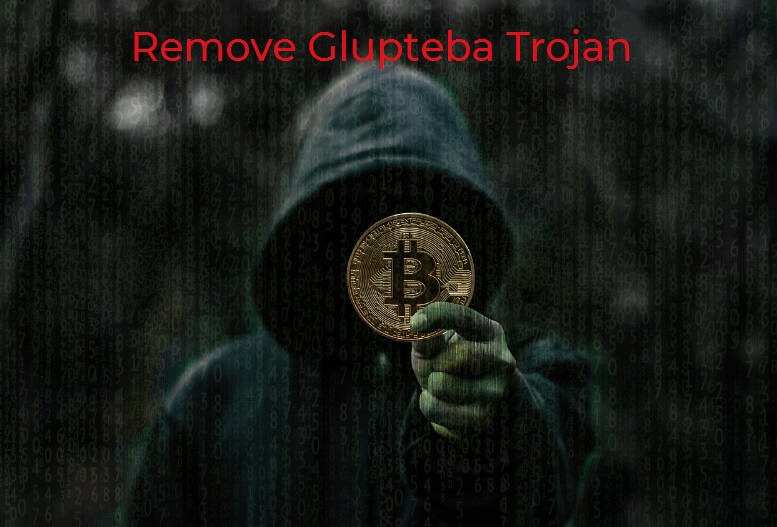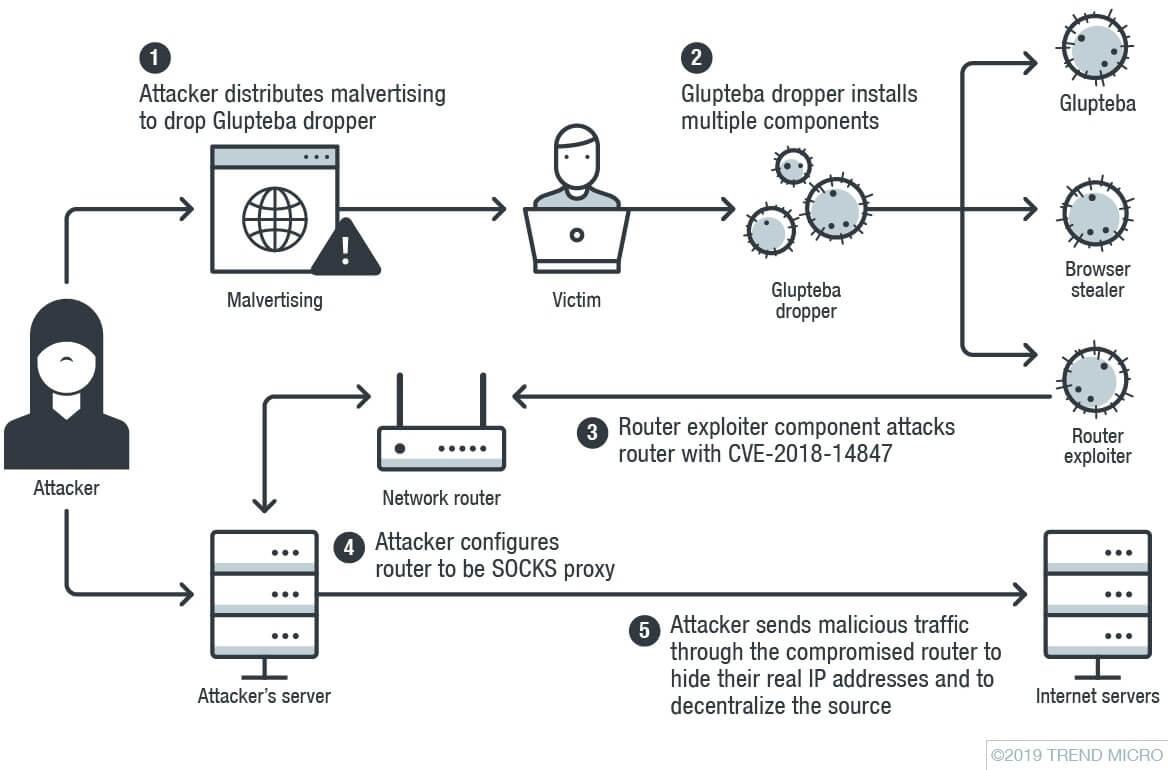Is Glupteba a Trojan? Can Glupteba exploit your router? Can Glupteba get back after its removed?
Glupteba is the name of a Trojan horse previously detected by cybersecurity experts and known to mine the Monero cryptocurrency, act like a password and data stealer. The current version of the Glupteba Trojan horse has evolved. Recently it has been documented that the malicious authors behind the Trojan have kept it alive and running by using Bitcoin via an Electrum wallet. The Trojan is made to drop a few malicious parts inside a victim’s computer while exploiting the nearest router of the compromised network. The Glupteba Trojan got inside your machine without your permission and could try to steal credential data and personal information. It is in your best interest to remove the Glupteba Trojan as fast as possible.

Threat Summary
| Name | Glupteba |
| Type | Trojan Horse, Miner Malware |
| Short Description | Glupteba is a Trojan horse that can mine cryptocurrency, steal passwords and other data and exploit routers and other devices over a network. |
| Symptoms | You may see a rise in the usage of your computer’s resources like CPU, RAM or GPU, while your computer will accordingly consume more electric power and may even overheat if a cryptocurrency miner is involved. |
| Distribution Method | Freeware Installations, Bundled Packages, JavaScript |
| Detection Tool |
See If Your System Has Been Affected by malware
Download
Malware Removal Tool
|
| User Experience | Join Our Forum to Discuss Glupteba. |
Glupteba Trojan – Distribution Information
The Glupteba Trojan malware could spread through a few methods, the most effective of which is explained in the following paragraphs.
How the process works in chronological order – the authors send Bitcoin transactions via a designated Electrum Bitcoin wallet, which was threatened by a prolific phishing campaign in the past. Glupteba, programmed with a hardcoded ScriptHash string, then makes its way via a public list of Electrum servers to find every transaction made by the cybercriminals.
Inside said transactions lies the OP_RETURN command data which contains an encrypted Command and Control domain. The ScriptHash string is set to decrypt the data once it has been received. This acts as a re-pinging to the host, with each new Bitcoin transaction making a new C&C connection.
The process is also showcased in the below infographic made by TrendMicro:
As clever this might be, if you do not click on suspicious and unknown links from emails and notifications, you should be safe. As the attack exploits routers on an infected network, make sure the firmware of your router is the latest version and always update it regularly.
The Glupteba Trojan might also be delivered via exploit kits or in other ways, but that is unknown for the time being.
Malware researchers from Norton have also delved deep inside the Glupteba Trojan. After Glupteba Trojan gets inside your machine without your permission, said malware sets a few parts in different places of your computer. For example, the mutex Global\MD7H82HHF7EH2D73 is created, but not before the following actions have been executed:
The following files are placed inside a victim computer system:
- %UserProfile%\Local Settings\Application Data\NVIDIA Corporation\Updates\NvdUpd.exe
- %UserProfile%\Local Settings\Application Data\NVIDIA Corporation\Updates\NvdUpd.exe.bak
After the files, the following registry entries are created (the last of which is to maintain persistence and load the malware after each Windows start) :
→HKEY_CURRENT_USER\Software\NVIDIA Corporation\Global\nvUpdSrv\”value” = “[GENERIC NUMBER]”
→HKEY_CURRENT_USER\Software\NVIDIA Corporation\Global\nvUpdSrv\”GUID” = “[GENERIC GUID]”
and
→HKEY_CURRENT_USER\Software\Microsoft\Windows\CurrentVersion\Run\”NvUpdSrv” = “%UserProfile%\Local Settings\Application Data\NVIDIA Corporation\Updates\NvdUpd.exe”
Below you can see some useful tips that can help you to prevent similar Trojan malware from installing onto your PC, in the future:
- Run programs inside a sandbox environment
- Install an advanced anti-malware protection
- Update your mostly-used programs and software in general
- Update your OS with security updates
- Install an ad-blocker application
- Be wary around your e-mails and don’t open them unless you know the source
- Disable macros in Microsoft Office Applications
- Keep your firewall ON
Glupteba Trojan will probably try to extract as much information as possible based on its capabilities and try to propagate further on a network to access other devices. It is highly recommend that you remove the malware threat, because the Glupteba Trojan because its purpose it to open your computer for other malware threats to access it.

Remove Glupteba Trojan Completely
To remove Glupteba Trojan manually from your computer, follow the step-by-step removal tutorial written down below. In case this manual removal does not get rid of the miner malware completely, you should search for and remove any leftover items with an advanced anti-malware tool. Such software can keep your computer secure in the future.
Preparation before removing Glupteba.
Before starting the actual removal process, we recommend that you do the following preparation steps.
- Make sure you have these instructions always open and in front of your eyes.
- Do a backup of all of your files, even if they could be damaged. You should back up your data with a cloud backup solution and insure your files against any type of loss, even from the most severe threats.
- Be patient as this could take a while.
- Scan for Malware
- Fix Registries
- Remove Virus Files
Step 1: Scan for Glupteba with SpyHunter Anti-Malware Tool



Step 2: Clean any registries, created by Glupteba on your computer.
The usually targeted registries of Windows machines are the following:
- HKEY_LOCAL_MACHINE\Software\Microsoft\Windows\CurrentVersion\Run
- HKEY_CURRENT_USER\Software\Microsoft\Windows\CurrentVersion\Run
- HKEY_LOCAL_MACHINE\Software\Microsoft\Windows\CurrentVersion\RunOnce
- HKEY_CURRENT_USER\Software\Microsoft\Windows\CurrentVersion\RunOnce
You can access them by opening the Windows registry editor and deleting any values, created by Glupteba there. This can happen by following the steps underneath:


 Tip: To find a virus-created value, you can right-click on it and click "Modify" to see which file it is set to run. If this is the virus file location, remove the value.
Tip: To find a virus-created value, you can right-click on it and click "Modify" to see which file it is set to run. If this is the virus file location, remove the value.Step 3: Find virus files created by Glupteba on your PC.
1.For Windows 8, 8.1 and 10.
For Newer Windows Operating Systems
1: On your keyboard press + R and write explorer.exe in the Run text box and then click on the Ok button.

2: Click on your PC from the quick access bar. This is usually an icon with a monitor and its name is either “My Computer”, “My PC” or “This PC” or whatever you have named it.

3: Navigate to the search box in the top-right of your PC's screen and type “fileextension:” and after which type the file extension. If you are looking for malicious executables, an example may be "fileextension:exe". After doing that, leave a space and type the file name you believe the malware has created. Here is how it may appear if your file has been found:

N.B. We recommend to wait for the green loading bar in the navigation box to fill up in case the PC is looking for the file and hasn't found it yet.
2.For Windows XP, Vista, and 7.
For Older Windows Operating Systems
In older Windows OS's the conventional approach should be the effective one:
1: Click on the Start Menu icon (usually on your bottom-left) and then choose the Search preference.

2: After the search window appears, choose More Advanced Options from the search assistant box. Another way is by clicking on All Files and Folders.

3: After that type the name of the file you are looking for and click on the Search button. This might take some time after which results will appear. If you have found the malicious file, you may copy or open its location by right-clicking on it.
Now you should be able to discover any file on Windows as long as it is on your hard drive and is not concealed via special software.
Glupteba FAQ
What Does Glupteba Trojan Do?
The Glupteba Trojan is a malicious computer program designed to disrupt, damage, or gain unauthorized access to a computer system. It can be used to steal sensitive data, gain control over a system, or launch other malicious activities.
Can Trojans Steal Passwords?
Yes, Trojans, like Glupteba, can steal passwords. These malicious programs are designed to gain access to a user's computer, spy on victims and steal sensitive information such as banking details and passwords.
Can Glupteba Trojan Hide Itself?
Yes, it can. A Trojan can use various techniques to mask itself, including rootkits, encryption, and obfuscation, to hide from security scanners and evade detection.
Can a Trojan be Removed by Factory Reset?
Yes, a Trojan can be removed by factory resetting your device. This is because it will restore the device to its original state, eliminating any malicious software that may have been installed. Bear in mind that there are more sophisticated Trojans that leave backdoors and reinfect even after a factory reset.
Can Glupteba Trojan Infect WiFi?
Yes, it is possible for a Trojan to infect WiFi networks. When a user connects to the infected network, the Trojan can spread to other connected devices and can access sensitive information on the network.
Can Trojans Be Deleted?
Yes, Trojans can be deleted. This is typically done by running a powerful anti-virus or anti-malware program that is designed to detect and remove malicious files. In some cases, manual deletion of the Trojan may also be necessary.
Can Trojans Steal Files?
Yes, Trojans can steal files if they are installed on a computer. This is done by allowing the malware author or user to gain access to the computer and then steal the files stored on it.
Which Anti-Malware Can Remove Trojans?
Anti-malware programs such as SpyHunter are capable of scanning for and removing Trojans from your computer. It is important to keep your anti-malware up to date and regularly scan your system for any malicious software.
Can Trojans Infect USB?
Yes, Trojans can infect USB devices. USB Trojans typically spread through malicious files downloaded from the internet or shared via email, allowing the hacker to gain access to a user's confidential data.
About the Glupteba Research
The content we publish on SensorsTechForum.com, this Glupteba how-to removal guide included, is the outcome of extensive research, hard work and our team’s devotion to help you remove the specific trojan problem.
How did we conduct the research on Glupteba?
Please note that our research is based on an independent investigation. We are in contact with independent security researchers, thanks to which we receive daily updates on the latest malware definitions, including the various types of trojans (backdoor, downloader, infostealer, ransom, etc.)
Furthermore, the research behind the Glupteba threat is backed with VirusTotal.
To better understand the threat posed by trojans, please refer to the following articles which provide knowledgeable details.




